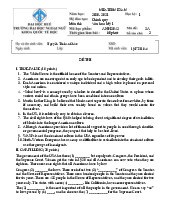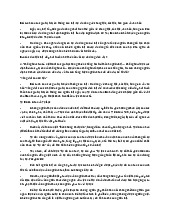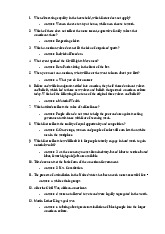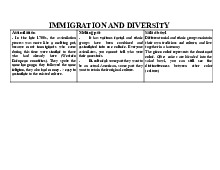






Preview text:
lOMoAR cPSD| 58794847 AMERICAN CULTURE
UNIT 1: Immigration and Diversity in the United States
WHAT DID THE IMMIGRANTS CONTRIBUTE TO THE U. S. SOCIETY?
THE ROLE OF IMMIGRANTS FOR THE US 1. Settle the West
2. Provide a source of fresh energy for the economic development
3. Supply new professionals and scientists
4. Enrich and diversify the American Culture 5. Contribute to the growth of the cities/urbanize
CULTURAL ASSIMILATION:
A MELTING POT OR A SALAD BOWL?
According to this theory, peoples from various cultures come to America and contribute aspects of
their culture to create a new, unique American culture. The result is that contributions from many
cultures are indistinguishable from one another and are effectively "melted" together.
According to this theory, there are times when newly arrived immigrants do not lose the unique
aspects of their cultures like in the melting pot model, instead they retain them. The unique
characteristics of each culture are still identifiable within the larger American society, much like
the ingredients in a salad are still identifiable, yet contribute to the overall make up of the salad bowl.
WHY IS THERE DISCRIMINATION?
When there is a dominant culture, the people who are part of that culture determine what society
approves and what society disapproves.
When people ARE NOT a part of the dominant culture, they face the pressure to do the following:
- assimilate – completely adapt to the dominant culture
- integrate – unify with the dominant culture while retaining their individual identity
- segregate – completely separate from the group (the dominant group usually segregates others from them).
THE ESTABLISHMENT OF THE DOMINANT CULTURE
The dominant culture:
WASPs = White Anglo-Saxon Protestants, English-speaking, Western European, Protestant and middle class.
HOW WERE NON-PROTESTANTS AND NON-WESTERN EUROPEANS ABLE TO ASSIMILATE? - Dominant values and beliefs
- Immigrants were "so accustomed to lives of poverty and dependence - American
values: Freedom, self-reliance and competition. - " Political bosses "(cities of northeastern US).
- Helped immigrants · immigrants vote for them - Rapidly expanding economy
- New opportunities, new rewards
- Immigrants were willing to give up their individual culture to become rich in America.
- African-Americans = most difficulty assimilating
- African-Americans were brought over as slaves for European immigrants Did not want to be in the U.S. lOMoAR cPSD| 58794847
The African – American experience The Civil War 1861-1865 Civil War: America was two nations:
- North – industrial & against slavery
- South farming cotton & tobacco = dependent on slaves from Africa
1861: S wanted their own nation because N was against slavery war
1863: Lincoln gave Emancipation Proclamation – freedom to slaves 1865:
S surrender to N, civil war ends.
The African – American experience. The Civil Rights Movement of the 1950s and 1960s The
segregation between whites and non-whites. Segregation is an extreme form of discrimination,
where people are forced to separate themselves based on the color of their skin.
THE CIVIL RIGHTS MOVEMENT
Martin Luther King, Jr: A black minister
+ Non-violent marches and demonstrations against segregation and other forms of racial discrimination
+ Was assassinated by a gunman in 1968.
Malcolm X: African-American Muslim minister and human rights activist
+ Initially advocated black supremacy and segregation of black and white Americans +
Eventually joined forces with civil rights movement, while advocating for self-determination and self-defense
+ Was killed by multiple gunshots in 1965
Two major civil rights laws were passed remove racial segregation from public
facilities in the South remove the barriers that had prevented black people from voting in that region.
RACE RELATIONS AFTER THE CIVIL RIGHTS MOVEMENT
The amount white prejudice toward black was reduced:
- College and university attendance - Income increase - Elective public office
- Higher involvement in politics and society
Still a gulf between races: Poverty, unemployment, violence and despair A UNIVERSAL NATION
America is more so a mosaic.
+ Smaller units coming together to make a beautiful picture
+ Individual cultures integrating to create a larger, heterogeneous culture.
UNIT 2: TRADITIONS AND ADAPTING CULTURES
“Barba Nikos” Review (with vocabulary)
- This was a story of cultural diversity, even though the narrator and Barba Nikos shared the same ethnic background.
- The narrator inherited his culture (Greek), and his heritage lies in the ingredients in Barba Nikos shop.
- They both had different personal identities: lOMoAR cPSD| 58794847
+ Barba Nikos represents the old country (Greece) Being
Greek was a source of pride for him
+ Narrator represents Americanized Greeks (people who lost their culture willingly)
Being Greek was a source of embarrassment “Barba
Nikos”: Which one did the narrator do?
assimilate – completely adapt to the dominant culture
He turned against his own people (Greek) to fit in with his American friends.
integrate – unify with the dominant culture while retaining their individual identity He
and his family eat Greek foods during holidays.
segregat e – completely separate from the group (the dominant group usually segregates others from them)
The old neighborhood may have been informally segregated by cultural identity, but not by race.
Ingredients of Greek Culture (p. 15)
In the story, Barba Nikos criticizes the narrator for not understanding the true meaning of each ingredient in his store:
“You are a stupid boy, “the old man said.” You are not really Greek, are you?” “Yes, I am.”
“You might be, “he admitted grudgingly.” But you do not act Greek . Wrinkling your nose at these
fine olives. Look around this store for a minute. What do you see?” “Fruits and vegetables, “I
said.” Cheese and olives and things like that.”
He stared at me with a massive scorn. “That's what I mean, “he said.” You are a bonehead. You
don't understand that a whole nation and a people are in this store.”
UNIT 3: TRADITION OF VALUES AND BELIEFS
People come to America because they believe in the following: Individual freedom, equal
opportunity, and material wealth . However, the outcomes of each are respectively self-reliance, competition, and hard work.
# 1: Individual freedom and self-reliance.
Value / Belief: INDIVIDUAL FREEDOM •
Many immigrants came to America to find freedom from controlling government or religious persecution •
Beginning of American's colonial rule: Class separation of" nobles "(rich) and" commoners "(poor) -
Changed when colonists declared freedom from British
rule. + Result of freedom from British rule:
+ “Don't tell me what to do; it's my life.” People govern, not kings No ruling class (nobility)
Separation of church and state
+ The power shared between federal (national) and states (regional)
+ Outcome of Value/Belief: SELF-RELIANCE
+ “You should be able to stand on your own two feet.”
+ You are looked up to if you are able to do things on your own. lOMoAR cPSD| 58794847
+ The Reality: - People are pressured to move out of their family's homes as early
as possible – 18 – 21 years old.
People are unwilling to receive charity or government help to avoid seeming weak.
People look down on beggars, thinking that it's their fault that they're poor.
In 2017, there were 39.7 million people in poverty
About 15 million children in the United States – 21% of all children – live
in families with incomes below the federal poverty threshold
#2: Equal Opportunity and Competition
Value/Belief: EQUAL OPPORTUNITY
Everyone has chance to succeed because freedom from overpowering government and social hierarchy (classes)
- “Old country”– hereditary aristocracy; noble families had power, wealth, land that they
inherited. No one else had much chance to succeed
- “New country”– status and opportunity are not based on your birth / position in society –
the harder you work, the more you succeed.
Outcome of Value/Belief: COMPETITION
- “Life is a race”– rule must be equal, competition must be fair
- American society trains people to compete
+ Competition makes people energetic, motivated
+ Popularity of sports and competition throughout schools, in nearly all aspects
+ It's everyone's duty to try -- effort is rewarded The Reality:
- Children = trained early to engage in competition, they are fixed on the winning/losing mentality ~ pressure, stress
- Women and people of color = historically disadvantaged
- Some people are richer than others = inherited advantage
- Elderly = Emotional strain; feel useless when not involved in highly competitive society
• Women earn less than men (75%) in the workplace
• People of color earn less than white people
#3: Material wealth and hard work
Value / Belief: MATERIAL WEALTH
- Many immigrants came to escape poverty, America was known for being a land of wealth, abundant natural resources
- Wealth is seen as a reward for hard work – wealth had to come through earning it; natural
resources had to be developed through hard work –“Money talks”
- The “American Dream”: “Going from rags to riches”
+ belief that any American can succeed and become rich if they simply work hard
enough + Status and success became based on material wealth
Outcome of Value / Belief: HARD WORK
- You must earn material wealth and respect through hard work.
- “Burning the candle at both ends” o Stress o Workaholic
- As economy move from industry-based to service-based, fewer high-paid jobs are
available, more difficult to become wealthy - The Reality: lOMoAR cPSD| 58794847
o American Dream less likely = different economy now o
Citizens judge people who use welfare
- “welfare mothers”= young women who do not marry or hold a job and have children and
are support by payments from the government
- Some women actually choose not to get married because the father is not good enough
Unit 4: American Government (Legislative, Executive, and Judicial Branches) A New Nation
- The British colonized America in 1600s.
- The British colonists wanted to declare freedom from England / the King in 1776
- American Revolution - colonists won and eventually established The United States of America
Let's Put it in Writing
• The first written document – 1781 – Articles of Confederation
• rules were too loose The Constitution – official in 1789
• Sets the basic form of American government
• 3 branches: Executive, legislative, judicial
• System of" checks and balances "for each branch
• No one branch or institution gets the ultimate power – belongs to the people
• “Supreme Law of the Land” – ALL government groups (federal, state, local) MUST follow its guidelines.
The Bill of Rights •
The Constitution didn't make clear many of the basic rights of American people
(civil rights) The Bill of Rights – 1791 – fundamental rights of any American
1) Freedom of speech, press, religion and petition
2) Right to keep and bear arms
3) Government cannot house soldiers in private homes without consent
4) Need probable cause and search warrant before you search someone's home
5) Cannot be charged for the same crime twice; can't be forced to testify against yourself (“plead the 5th”)
6) Right to a speedy and public trial and defense lawyer in criminal case
7) Right to trial by jury in civil case
8) No cruel and unusual punishment or excessive bail
9) Protection of rights not stated in the Constitution
10) Powers not given to government are reserved for states, or people •
“unalienable” rights – you are born with them and they can't eve be taken away •
designed to serve the people and carry out their majority wishes •
People did NOT want the government to control them (they had that in England) ~
still dislike of “big government” today The American System of Government
1) One person, one vote – representatives are elected based on number of people so
everyone is fairly and evenly represented
2) Checks and Balances – no system has complete power – they all influence each other Legislative lOMoAR cPSD| 58794847 •
Congress = Senate + House of Representatives • Meet in Capitol Hill •
Senate: 100 Senators, 2/state; 1/3 elected every 2 years for 6 years in office •
House: 435 members; elected every 2 years for 2 year terms •
Number of representatives is based on state population (California has 53 votes, Delaware has 1) •
Speaker of the House leads Congress sessions (currently Democrat Nancy
Pelosi) Executive • President • Elected by the people • 4-year term • Maximum: 2 terms •
Vice-President elected along with President •
Majority of Congress can be one political party while the president is the
other ( i. E. Republican Congress with Democrat President) •
This can make it difficult for the President to get laws passed (has to have
approval from both houses before law passes) •
Different departments within executive branch – State, Treasury, Defense,
Justice, Interior, Agriculture, Labor, Housing and Urban Development, Energy, Education, etc. •
Head of each department chosen by the president (as long as approved by Senate) •
They are like assistants to the president –" cabinet " Judicial •
Supreme Court – watches over the other two branches •
Decides whether laws passed by Executive and Legislative follow the
guidelines of the Constitution •
Chief Justice (judge) and 8 associate judges; nominated by President (approved by Senate) • Have office for LIFE •
Supreme Court is the highest court in America ~ its decisions cannot be appealed (neither
President nor Congress can change their decision) Checks and Balances •
The powers given to each branch are carefully balanced •
Each branch serves as a check for the other two (to keep any branch from getting too much power) •
Congress makes laws – President can veto [veto -reject a decision or proposal] •
Congress can undo the veto with 2/3 vote in each house •
Congress can also refuse to give money to the President lOMoAR cPSD| 58794847 •
Because of this system - compromise is necessary [compromise - an
agreement or a settlement of a dispute that is reached by each side giving up something
they want] • President really isn't as powerful as many people think
Political Parties (Liberal vs. Conservative ; Democrat vs. Republican) •
Constitution doesn't talk about any parties, but over time the US has developed a twoparty system •
There are other parties, but they don't have much influence and don't play a role in national politics •
Democrats – like bigger role of government in society; new thinking;" liberal " •
Republicans – oppose greater involvement of government;" conservative"; traditional •
Several issues that divide them – (abortion, gay rights, taxes, universal
health care, business, etc) • Many vote for president based on the specific issues, not only based on party •
Congress representing state has to vote for who their people want (Ex:
California senators will most likely vote for Obama because California is very liberal / democratic) Presidential Party Platforms Clinton / Democrat Platform •
tuition-free public college/university • more gun-control laws enacted •
undocumented immigrants allowed to become legal residents •
US should NOT send ground troops to fight ISIS Trump / Republican Platform •
students must pay the tuition fee • no more gun-control •
deporting undocumented immigrants
US ground troops should fight against ISIS



